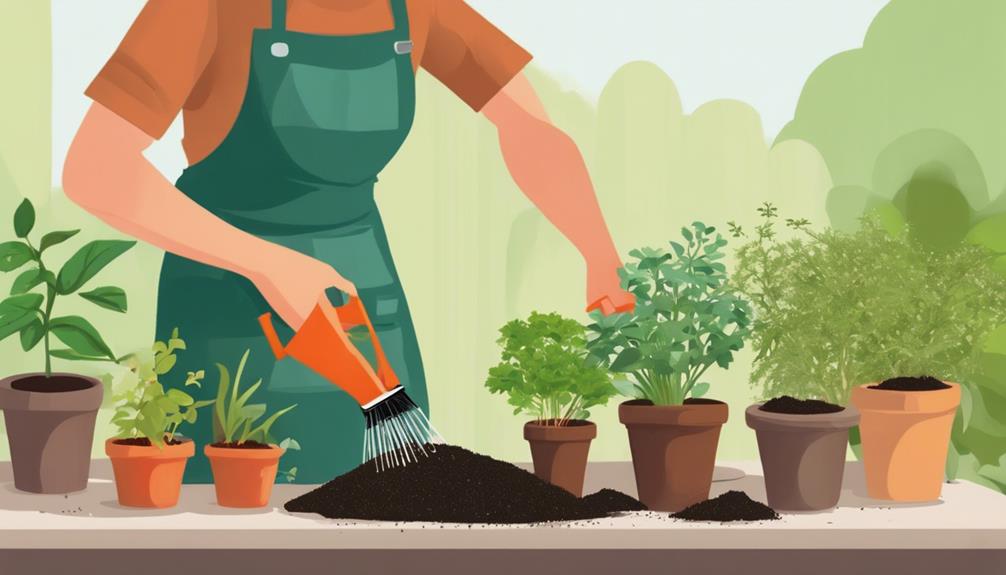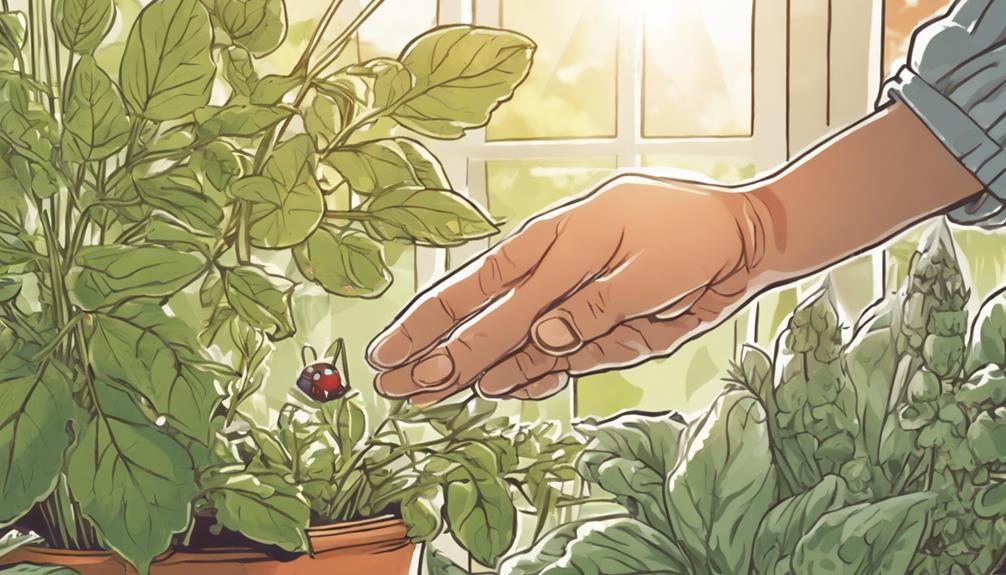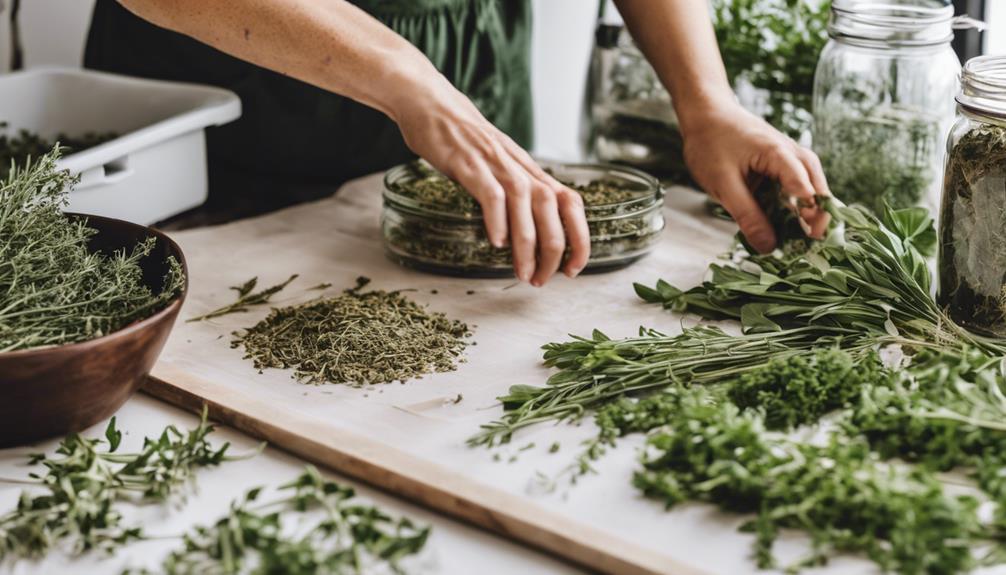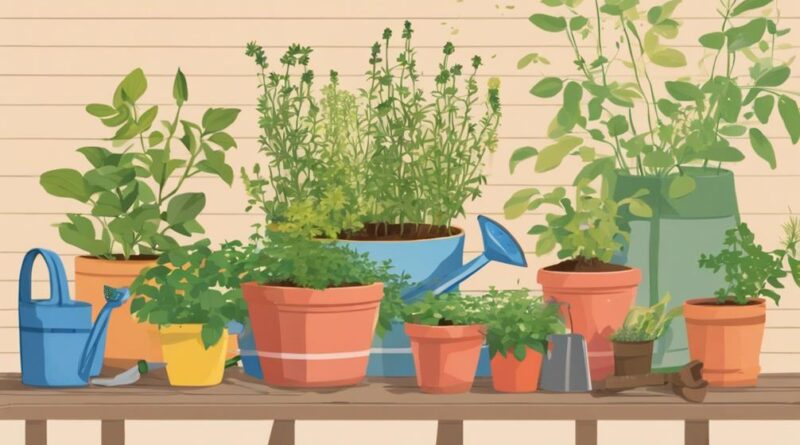11 Essential Steps to Start Your Home Herb Garden
This post may contain affiliate links which means I may receive a commission for purchases made through links. As an Amazon Associate, I earn from qualifying purchases. Learn more on my Private Policy page.
To start your home herb garden successfully, follow these 11 essential steps. Choose a sunny spot with good drainage for optimal growth. Select herbs suited for indoor growth and plant seeds correctly. Water carefully, checking moisture levels and ensuring proper drainage. Consider organic fertilizers and weed management techniques. Keep an eye out for pests and harvest herbs in the morning for better flavor. Preserve herbs by drying, freezing, or making herb butter. These steps lay the groundwork for a bountiful herb garden at your fingertips. Your journey to a thriving herb garden awaits with these essential tips.
Choosing the Right Location
When selecting the ideal spot for your home herb garden, prioritize sunlight and accessibility for a thriving herb haven. Sunlight exposure is crucial for the growth and flavor of your herbs. Choose a location that receives at least 6-8 hours of sunlight per day, preferably in the morning when the light is gentler. Herbs like basil, rosemary, and thyme thrive in full sun, while others such as mint and parsley can tolerate partial shade.
Ensure that the chosen spot has well-draining soil to prevent waterlogging, which can lead to root rot. Testing your soil quality can help determine if any amendments are needed to optimize herb growth.
Temperature control is another vital aspect to consider when selecting the right location for your herb garden. Most herbs prefer temperatures between 60-70°F (15-21°C) but can tolerate slight fluctuations. Avoid areas with extreme temperature variations or strong drafts that can stress the plants.
Moisture levels are also essential for herb growth. Ensure that the location isn't prone to waterlogging or drought conditions. Consider the proximity to a water source for easy irrigation. By carefully evaluating sunlight exposure, soil quality, temperature control, and moisture levels, you can create an optimal environment for your home herb garden to flourish.
Selecting Herb Varieties
To ensure a diverse and thriving home herb garden, carefully select a variety of herbs that suit your culinary needs and growing conditions. When choosing herb varieties, consider herb companion planting to maximize growth and flavor. Some herbs, like basil and tomatoes, benefit each other when planted together, while others, like fennel and dill, inhibit each other's growth. Researching companion planting will help you create a harmonious herb garden that flourishes.
For indoor herb growing, select herbs that thrive in indoor environments with limited sunlight. Herbs like mint, chives, and parsley are well-suited for indoor cultivation as they can tolerate lower light conditions. Additionally, consider the space you have available when choosing herbs for indoor planting. Compact herbs like thyme, oregano, and rosemary are ideal for small indoor herb gardens, as they don't require a lot of space to grow.
When selecting herb varieties, also think about your culinary preferences. If you enjoy Italian cuisine, consider planting basil, oregano, and parsley. For those who love Mexican dishes, cilantro, cumin, and Mexican tarragon could be excellent choices. Tailoring your herb selection to your cooking style will enhance your culinary creations and make your home herb garden a source of fresh and flavorful ingredients.
Preparing the Soil
Wondering how to best prepare the soil for your home herb garden? Soil preparation is a crucial step in ensuring your herbs thrive. Start by assessing the nutrient levels in your soil. You can do this by using a soil testing kit available at most gardening stores or through your local agricultural extension office. Knowing the nutrient levels will help you determine if any amendments are needed to create an optimal growing environment for your herbs.
Once you have determined the nutrient levels, you may need to amend your soil to improve its quality. Adding organic matter such as compost or well-rotted manure can help improve the soil structure and provide essential nutrients for your herbs. Work the organic matter into the soil to a depth of about 6-8 inches to ensure that it's evenly distributed.
In addition to organic matter, you may also need to adjust the pH level of your soil. Most herbs prefer a slightly acidic soil with a pH level between 6 and 7. You can use a pH testing kit to determine the current pH level of your soil and amend it as necessary using products available at your local garden center.
Planting Seeds or Seedlings
For a successful start to your home herb garden, consider the best methods for planting seeds or seedlings. When planting seeds, ensure they're sown at the recommended depth and spacing in well-draining soil. Keep the soil consistently moist but not waterlogged to aid germination. Depending on the herb variety, you may need to cover the seeds lightly with soil or leave them exposed to sunlight for proper growth.
If you opt for seedlings, select healthy plants with vibrant green leaves and sturdy stems. When transplanting them into your garden, dig a hole slightly larger than the root ball and gently place the seedling in, ensuring the soil is packed firmly around it. Water the newly transplanted seedlings immediately to help them settle into their new environment.
Regardless of whether you choose seeds or seedlings, ensure your herbs receive adequate sunlight exposure. Most herbs require at least 6-8 hours of sunlight daily, so choose a location that meets this requirement. If you have limited space, consider container gardening or vertical planting options to make the most of available sunlight.
Providing Adequate Water
Ensuring your home herb garden receives the right amount of water is crucial for their growth and overall health. Proper watering practices play a significant role in the success of your herb garden. Here are some essential tips to help you provide adequate water for your herbs:
- Watering frequency: Herbs generally prefer slightly drier conditions, so it's important not to overwater them. Check the moisture level of the soil by inserting your finger about an inch deep. Water your herbs when the top layer of the soil feels dry to the touch.
- Soil moisture: Herbs thrive in well-draining soil that retains some moisture but doesn't become waterlogged. Make sure your pots have drainage holes to prevent water from pooling at the bottom, which can lead to root rot.
- Morning watering: It's best to water your herbs in the morning to allow excess moisture to evaporate during the day. This helps prevent fungal diseases that can develop in damp conditions.
- Consistency is key: Try to maintain a consistent watering schedule for your herbs. Fluctuating between periods of drought and heavy watering can stress the plants. Aim to water your herbs regularly but allow the soil to dry out slightly between waterings to promote healthy root growth.
Ensuring Proper Drainage
To ensure the health and longevity of your home herb garden, proper drainage is paramount. Adequate drainage is crucial in preventing waterlogged soil, which can lead to root rot and other issues. When selecting containers for your herbs, consider the size and material. Opt for containers with drainage holes at the bottom to allow excess water to escape. If your chosen container doesn't have drainage holes, you can create some by using a drill.
Proper drainage helps maintain the right soil moisture levels for your herbs. It allows excess water to drain out, preventing the soil from becoming oversaturated. When the soil stays too wet for too long, it can lead to root diseases and poor plant growth. Additionally, the size of the container plays a role in drainage. Larger containers generally provide better drainage as they've more soil volume to hold excess water.
When deciding on the container size, consider the specific needs of each herb. Some herbs, like rosemary and lavender, prefer drier soil and may benefit from a smaller container that drains well. On the other hand, herbs like basil and mint enjoy consistently moist soil and may thrive in larger containers with good drainage. By paying attention to soil moisture and container size, you can create an optimal environment for your home herb garden to flourish.
Fertilizing Your Herbs

Properly fertilizing your herbs is essential for their growth and overall health. Here are some key tips to help you fertilize your herbs effectively:
- Organic Options: Consider using organic fertilizers for your herbs. Organic options such as compost or well-rotted manure provide essential nutrients to your herbs without the risk of chemical build-up in the soil. Apply these organic fertilizers in the early spring to give your herbs a nutrient boost as they start growing.
- Timing is Key: When fertilizing your herbs, timing is crucial. Avoid over-fertilizing, as this can lead to nutrient imbalances and potentially harm your herbs. It's best to fertilize your herbs during their active growing period, usually in the spring and early summer. Remember to follow the specific instructions on the fertilizer package for optimal results.
- Natural Alternatives: Explore natural alternatives like compost tea or seaweed extract. These alternatives not only provide nutrients to your herbs but also improve soil structure and promote beneficial microorganisms. Natural fertilizers offer the added benefit of being environmentally friendly and sustainable.
- Benefits of Natural Options: Using natural fertilizers can enhance the flavor and aroma of your herbs. They help maintain a healthy ecosystem in your herb garden, attracting beneficial insects and creating a balanced environment for your plants to thrive. By opting for natural alternatives, you contribute to the overall well-being of your herbs and the environment.
Managing Weeds
When tending to your home herb garden, effectively managing weeds is crucial for maintaining the health and growth of your herbs. Weed control is essential to prevent unwanted plants from competing with your herbs for nutrients, water, and sunlight. To keep weeds at bay, regularly inspect your herb garden and manually remove any weeds that you spot. This hands-on approach is an effective way to prevent weeds from taking over and harming your herbs.
In addition to manual weeding, you can also use mulch to help suppress weed growth. Mulching not only helps in weed control but also aids in moisture retention and temperature regulation around your herbs. Organic mulches like straw, grass clippings, or wood chips can be beneficial for your herb garden while deterring weed growth.
Furthermore, proper spacing between your herbs can also aid in weed control. When herbs are planted too closely together, they can create a dense canopy that prevents sunlight from reaching the soil, promoting weed growth. By giving your herbs adequate space to grow, you reduce the chances of weeds flourishing.
Monitoring Pests

Effective pest monitoring is essential for safeguarding the health and vitality of your home herb garden. To ensure your herbs thrive, here are some practical steps you can take:
- Regular Inspection: Make it a habit to inspect your herb plants regularly. Look for any signs of pest damage such as holes in leaves, chewed edges, or discoloration. Early detection is key to preventing pest infestations from spreading.
- Natural Pest Control: Embrace natural pest control methods to protect your herbs. Introduce beneficial insects like ladybugs or lacewings that feed on common garden pests. You can also use homemade remedies like neem oil spray or garlic spray to deter pests.
- Companion Planting: Utilize companion planting techniques to naturally repel pests. Some herbs like basil, mint, and lavender act as natural pest deterrents when planted alongside other herbs. This strategy not only helps in pest control but also promotes biodiversity in your garden.
- Handpicking: Sometimes the best way to deal with pests is by handpicking them off your plants. Check the underside of leaves and along stems for any pests like caterpillars or aphids. By removing them manually, you can prevent further damage without the need for harsh chemicals.
Harvesting Herbs
To ensure the best flavor and potency in your herbs, timing and technique are crucial when it comes to harvesting. For optimal results, harvest your herbs in the morning after the dew has dried but before the sun is high. This is when the essential oils are most concentrated, enhancing both the culinary uses and medicinal benefits of the herbs. When harvesting, use sharp scissors or shears to make clean cuts just above a leaf node to encourage bushier growth.
After harvesting, there are various ways to preserve your herbs. Drying techniques are ideal for herbs like rosemary, thyme, and oregano. Hang them upside down in small bunches in a warm, dry place with good air circulation. Once dried, store them in airtight containers away from direct sunlight. Infusing oils is another popular method, where herbs like basil or mint are submerged in oil to impart their flavors.
When it comes to culinary uses, freshly harvested herbs can elevate the taste of any dish. Whether you're making a marinade, salad, or seasoning a roast, using herbs straight from your garden can add a depth of flavor that dried herbs often lack. Additionally, many herbs offer medicinal benefits, such as calming chamomile tea or soothing lavender salves. Harvesting your herbs at the right time and using them correctly can greatly enhance your cooking and wellness routines.
Preserving Herbs

For optimal preservation of your herbs, consider utilizing various methods such as drying, infusing oils, or freezing to extend their shelf life and retain their flavors.
Here are some practical ways to preserve your herbs:
- Drying Techniques: One of the oldest and most effective methods to preserve herbs is by drying. To dry your herbs, tie them in small bundles and hang them upside down in a warm, well-ventilated area. Once dried, remove the leaves from the stems and store them in airtight containers away from direct sunlight.
- Infusing Oils: Infusing oils with herbs not only preserves them but also creates flavorful oils for cooking. Simply place clean, dry herbs in a clean glass jar and cover them with oil. Let the mixture sit for a few weeks to allow the herbs to infuse their flavor into the oil. Strain out the herbs and store the infused oil in a cool, dark place.
- Freezing Herbs: Freezing herbs is a quick and convenient way to preserve their freshness. Chop the herbs and place them in ice cube trays, covering them with water or oil. Once frozen, transfer the herb cubes into a freezer-safe bag for easy use in cooking.
- Making Herb Butter: Herb butter is a delicious way to preserve and enhance the flavors of your herbs. Simply mix finely chopped herbs into softened butter, then roll it into a log using parchment paper. Store the herb butter in the refrigerator or freezer for later use on bread, meats, or vegetables.
Frequently Asked Questions
How Can I Protect My Herbs From Neighborhood Pets?
To protect your herbs from neighborhood pets, consider using pet-friendly herb deterrents like citronella or vinegar sprays. Additionally, explore herb garden fencing options such as low fences or chicken wire barriers to keep them out.
These solutions can help safeguard your plants without causing harm to the pets or disrupting the harmony of your garden. Finding the right balance will ensure your herbs stay safe and thriving in your home garden.
Are There Any Herbs That Repel Common Garden Pests?
When it comes to repelling common garden pests, consider companion planting as a natural deterrent.
Herbs like basil, chives, and mint can help keep unwanted insects away. These herbs release scents that pests find unappealing.
Additionally, attracting beneficial insects to your garden through companion planting promotes organic pest control.
What Tools Do I Need to Maintain My Herb Garden?
To maintain your herb garden effectively, you'll need a few essential tools. Make sure to have a reliable watering can for gentle watering sessions.
Pruning shears are handy for trimming back overgrown herbs. Keep your soil healthy with a trowel for aerating and a pH meter to monitor acidity levels.
When harvesting, use sharp scissors for clean cuts. Following these tips will help your herb garden thrive!
Can I Grow Herbs Indoors Without Natural Sunlight?
Yes, you can grow herbs indoors without natural sunlight by using artificial lighting. LED grow lights are ideal for indoor herb gardening as they provide the necessary spectrum of light for plant growth.
Another option is hydroponic herb gardening, which involves growing plants in water-based solutions.
Ensure your herbs receive around 12-16 hours of light per day and are placed near the light source to thrive indoors without natural sunlight.
How Do I Prevent Fungal Diseases in My Herb Garden?
To prevent fungal diseases in your herb garden, focus on organic solutions and prevention techniques. Ensure good soil quality with proper drainage systems in place. Avoid overwatering your herbs, as excess moisture can lead to fungal growth.
Prune regularly to increase air circulation around the plants. Consider using natural fungicides like neem oil or copper sprays if needed. By taking these steps, you can keep your herb garden healthy and disease-free.
Conclusion
Now that you have followed these essential steps to start your home herb garden, you're well on your way to enjoying a bountiful harvest of fresh herbs right at your fingertips.
Remember to continue providing care and attention to your plants, monitor their growth, and harvest them at the right time to ensure maximum flavor and freshness.
With a little effort and dedication, you can create a thriving herb garden that will enhance your culinary creations for months to come.
Happy gardening!
